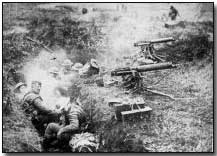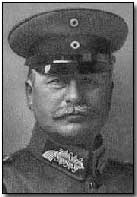Battles - The Battle of Cambrai, 1917
 The Battle of Cambrai, launched in November 1917, heralded the first time tanks
were used in significant force, a little over a year after they had made their tentative debut at Flers on the Somme in September 1916. By the
autumn of 1917 the popular reputation of tank effectiveness had suffered.
Aside from their undoubted initial value as a surprise tactic they were deemed to be of limited use in offensive
operations, unwieldy and prone to malfunction.
The Battle of Cambrai, launched in November 1917, heralded the first time tanks
were used in significant force, a little over a year after they had made their tentative debut at Flers on the Somme in September 1916. By the
autumn of 1917 the popular reputation of tank effectiveness had suffered.
Aside from their undoubted initial value as a surprise tactic they were deemed to be of limited use in offensive
operations, unwieldy and prone to malfunction.
So much so indeed that the German high command, having overcome their initial alarm at the sudden appearance of the huge mechanical beasts upon the battlefield, came to regard the tank with disdain, a device readily destroyed by use of concentrated field artillery. Given such an attitude it was perhaps unsurprising that German tank development came relatively late in the war.
Nevertheless the British Tank Corps remained convinced that earlier disappointments regarding tank use would be overcome once the new weapon was used in battlefield conditions less ill-suited than the muddy quagmire that characterised the Third Battle of Ypres, where once again the tank had succeeded only in generating cynicism.
Thus Lieutenant-Colonel John Fuller of the Tank Corps recommended wide-scale use of tanks upon the dry battlefield sited between the Canal du Nord and the St. Quentin Canal. Fuller's proposal was promptly taken up by Third Army commander Julian Byng - the commander on the ground - but was vetoed by British Commander-in-Chief Sir Douglas Haig who preferred to continue with operations at Passchendaele.
 In
time however Haig, disappointed at the lack of progress at Passchendaele,
turned back to Fuller and Byng's scheme, attracted by the notion of
achieving a useful victory using the new weapon before the year was
out.
In
time however Haig, disappointed at the lack of progress at Passchendaele,
turned back to Fuller and Byng's scheme, attracted by the notion of
achieving a useful victory using the new weapon before the year was
out.
Byng, buoyed with the opportunity the command gave him, rejected Colonel Fuller's initial plan calling for an immediate withdrawal once the massed tank formation had successfully raided the German lines. Instead he aimed at achieving a major Allied breakthrough.
He scheduled the attack for November, even though weather conditions were predictably worsening. Consequently Tank Corps commanders feared that the planned attack would merely serve once again to further undermine the tank's doubtful reputation as an effective attacking weapon.
The attack was duly launched at dawn on the morning of 20 November 1917, with all available tanks advancing across a 10 km front. 476 tanks were accompanied by six infantry and two cavalry divisions (the latter to exploit any breakthrough), plus a further 1,000 guns. 14 newly formed squadrons of the Royal Flying Corps stood by - a forerunner of the blitzkrieg tactics employed to great effect by the German army during the Second World War. Notably the attack was not preceded by a preliminary bombardment, helping to ensure complete surprise.
 Facing
the British attack was the German Second Army led by Georg von der Marwitz. Within hours the lightly defended Germans were forced
back some 6 km to Cambrai, the three trench systems of the Hindenburg Line pierced for the first time in the war.
Facing
the British attack was the German Second Army led by Georg von der Marwitz. Within hours the lightly defended Germans were forced
back some 6 km to Cambrai, the three trench systems of the Hindenburg Line pierced for the first time in the war.
The British achieved success all along the line, bar at Flesquieres (at the centre of the attack), where 51st Highland divisional commander Harper had determined not to work in tandem with tank commanders, suspicious of tank technology. Approximately 8,000 prisoners and 100 guns were captured on the first day alone.
Much encouraged (and greatly surprised) by the (for Western Front standards) notable gains of the first day, Haig determined to press on with the attack, although once the initial surprise had passed British gains proved much harder to come by; nevertheless, Flesquieres was seized the following day. Unfortunately for Byng a lack of available support to follow-up the surprise breakthrough of the first day resulted in a critical loss of momentum.
Erich Ludendorff, the effective head of the German Third Supreme Command, ordered an immediate counter-attack only to discover that reserves could not be brought forward for a further two days. At one stage he even contemplated a general withdrawal from the Cambrai front.
Marwitz, the local commander, may have been stunned by the onset of the attack on 20 November. However in pressing home wave after wave of German counterattacks, starting 20 November, he worked to recover all ground lost to the British.
Some 20 divisions were deployed during the German counter-attack, which deployed so-called Hutier infiltration tactics (named after the German commander who had first deployed them, Oskar von Hutier). Within a week virtually all lost ground had been reclaimed.
During the battle casualties were high: the Germans suffered losses of approximately 50,000 and the British 45,000. If ultimately the massed deployment of tanks had failed to achieve the desired for breakthrough, it had nevertheless demonstrated the potential for targeted use of the tank in offensive operations.
In Britain news of the initial spectacular breakthrough served to greatly enhance Byng's reputation; and it resulted in the ringing of church bells in Britain for the first time during the war.
Click here to view a map charting the progress of the battle.
Click here to read Arthur Conan Doyle's account of the battle. Click here to read German Army Chief of Staff Paul von Hindenburg's reaction.
Photographs courtesy of Photos of the Great War website
"Quirk" was British slang for the B.E. 2 two-seater aircraft.
- Did you know?
